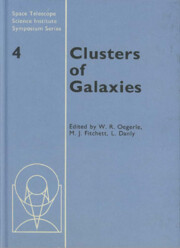Book contents
- Frontmatter
- Contents
- Preface
- Participants
- Chapter 1 Cosmology and Cluster Formation
- Chapter 2 Clusters of Galaxies: Structure, Infall, and Large-Scale Distribution
- Chapter 3 Cosmogony with Clusters of Galaxies
- Chapter 4 Cosmogony and the Structure of Rich Clusters of Galaxies
- Chapter 5 The Dark Matter Distribution in Clusters
- Chapter 6 The Effect of the Cluster Environment on Galaxies
- Chapter 7 Evidence for Gas Deficiency in Cluster Galaxies
- Chapter 8 Properties of Galaxies in Groups and Clusters
- Chapter 9 Dynamical Evolution of Clusters of Galaxies
- Chapter 10 Hot Gas in Clusters of Galaxies
- Chapter 11 Hydrodynamic Simulations of the Intracluster Medium
- Chapter 12 Evolution of Clusters in the Hierarchical Scenario
- Chapter 13 Distant Clusters as Cosmological Laboratories
- Chapter 14 Future Key Optical Observations of Galaxy Clusters
- Chapter 15 Cluster Research with X-ray Observations
- Plate section
Chapter 12 - Evolution of Clusters in the Hierarchical Scenario
Published online by Cambridge University Press: 06 July 2010
- Frontmatter
- Contents
- Preface
- Participants
- Chapter 1 Cosmology and Cluster Formation
- Chapter 2 Clusters of Galaxies: Structure, Infall, and Large-Scale Distribution
- Chapter 3 Cosmogony with Clusters of Galaxies
- Chapter 4 Cosmogony and the Structure of Rich Clusters of Galaxies
- Chapter 5 The Dark Matter Distribution in Clusters
- Chapter 6 The Effect of the Cluster Environment on Galaxies
- Chapter 7 Evidence for Gas Deficiency in Cluster Galaxies
- Chapter 8 Properties of Galaxies in Groups and Clusters
- Chapter 9 Dynamical Evolution of Clusters of Galaxies
- Chapter 10 Hot Gas in Clusters of Galaxies
- Chapter 11 Hydrodynamic Simulations of the Intracluster Medium
- Chapter 12 Evolution of Clusters in the Hierarchical Scenario
- Chapter 13 Distant Clusters as Cosmological Laboratories
- Chapter 14 Future Key Optical Observations of Galaxy Clusters
- Chapter 15 Cluster Research with X-ray Observations
- Plate section
Summary
Abstract. If the universe has closure density and the spectrum of primordial density fluctuations is a power law, the lack of any preferred scale means that the clustering should evolve in a scale invariant manner. These self-similar models allow one to approximately predict the evolution of the clustering in e.g., the ‘standard’ cold dark matter model. I describe how these models yield predictions for the evolution of the cluster populations. Particular attention is given to the range of spectral indices for which the scaling should be valid. I argue than the allowed range is −3 < n < 1, though quite what happens for spectra near the upper bound is somewhat unclear. The cold dark matter power spectrum has spectral index n ≃ −1 on the mass scale of clusters. For this value of n, I find that the comoving density of clusters classified according to virial temperature Tv or by Abell's richness, should show weak positive density evolution ∂log n(Tv, z)/∂z ≃ +0.3. Clusters classified by total X-ray luminosity should show strong positive density evolution ∂log n(Lx, z)/∂z ≃ +3, but the assumptions used to predict the total X-ray luminosity are somewhat questionable. More robust predictions can be made for the halo emission, and I describe an evolutionary test which should be feasible with ROSAT.
INTRODUCTION
Rich clusters have had much impact on cosmological theory. They give the strongest indication that the universe contains copious amounts of dark matter and give an empirical estimate of the baryon to dark matter ratio.
- Type
- Chapter
- Information
- Clusters of Galaxies , pp. 327 - 340Publisher: Cambridge University PressPrint publication year: 1990
- 1
- Cited by



